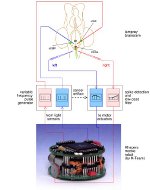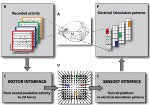
The “Spinal Brain”: a new approach to revolutionize “brain-to-machine” interfaces
The “Spinal Brain”: a new approach to revolutionize “brain-to-machine” interfaces
How neuroscience and neuroengineering can improve the quality of life of disabled people
During the 5th IEEE EMBS Neural Engineering Conference, Dr. Mussa-Ivaldi presented his research activities towards the development of a novel way to control external devices by brain activities. In the future, this new approach could help disabled people.
Neuroengineering is a novel discipline combining engineering including micro and nanotechnology, electrical and mechanical, and computer science with cellular, molecular, cognitive neuroscience with two main goals: (i) increase our basic knowledge of how the nervous system works; (ii) develop systems able to restore functions in people affected by different types of neural disability. In the past years, several breakthroughs have been reached by neuroengineers either in basic science and applications.
To highlight this emerging discipline, the IEEE Engineering in Medicine and Biology Society organizes the focused International IEEE EMBS Conference on Neural Engineering, which was recently held from April 27 through May 1, 2011, Cancun, Mexico. During the conference distinguished researchers have been invited to show their recent achievements. In particular, the plenary speaker was Ferdinando (Sandro) Mussa-Ivaldi who is Professor of Physiology, Physical medicine and Rehabilitation and Biomedical Engineering at Northwestern University. He is also the Director of the Robotics Laboratory of the Rehabilitation Institute of Chicago.
Dr. Mussa-Ivaldi briefly summarized the activities carried out by several researchers to understand how the primary motor cortex (M1) is able to generate the control commands to allow the upper limb to reach objects and how this kind of information has been used to develop “brain-to-machine” interfaces (BMIs) which are systems able to control artificial devices by processing signals recorded from M1.
Then, he presented a novel viewpoint in the field potentially able to achieve interesting and disruptive results. This perspective came to light with a work by Valentino Braitenberg, the founder of the Biological Cybernetics Institute at the Max Plank. Braitenberg wrote an intriguing little book, entitled “Vehicles”, which is situated between fiction, science, and philosophy.
The concept is a precursor of what became later known as “connectionism”. Suppose that some engineer crates a vehicle with optical sensors and wheels and suppose that the sensors are connected to the wheels in different ways. For example the sensor on the right excites the wheel on the left and vice-versa. Then, if a light is placed ahead and to the left of the vehicle, the wheel on the right side will spin faster than the wheel on the left because the two sensors are at different distances. A psychologist, unaware of the connections, would observe that the vehicle rushes toward the light, possibly smashing it. And he would perhaps interpret this behavior as a form of “aggression”. The engineer would manufacture different connection patterns and these would be analyzed in behavioral terms such as “love”, “fear” etc. The point is that there is a relation between the behavior and the underlying connectivity of the vehicle—as a metaphor of the brain. Then, we may construct such devices to explore connectivity in a real brain by observing the behaviors that they produce.
Dr. Mussa-Ivaldi first tested this approach some years ago: a very simple embodiment of Braitenberg’s Vehicles, by connecting a small mobile robot with the brain of a lamprey.
The robot had two optical sensors and two wheels. Each sensor generated a signal that the interface translated into an electrical stimulus that is delivered to the vestibular nucleus of the Lamprey. The right sensor stimulated the right nucleus and the left sensor stimulated the left nucleus. Two recording electrodes were placed downstream on the posterior rhombencephalic nuclei – part of the reticular formation – on the right and left sides of the midline. These nuclei received both ipsilateral and contralateral vestibular inputs. The population spikes were detected and their frequency drove the wheels on the right and left side of the robot, respectively. As a result, the robot engaged in some of the behaviors described by Braitenberg.
In combination with this connectionism approach Dr. Mussa-Ivaldi believes that it is necessary to develop BMIs which do not need to have all the details specified by the user: it would be desirable to set at any instant an initial condition and “let things flow” or you can keep correcting this initial condition. We have a natural brain-machine interface that does just this: is the spinal cord. Therefore, Dr. Mussa-Ivaldi is now collaborating with Dr Alessandro Vato and other colleagues in Genoa on the development of a novel bidirectional BMIs that emulate the spinal cord – or at least some of its many functions. In their first prototype, the brain of an anesthetized rat is implanted with two electrode arrays: a stimulation array in the sensory cortex and a recording array in the motor cortex. On the other side of the interface there is a very simple mechanical element: a simulated point mass that moves over a planar surface. The position of the point mass is translated – by a sensory encoder -into an electrical stimulus to the sensory cortex. The multi-unit activity recorded from the motor cortex is converted – by a motor decoder- into a force vector applied to the point mass. Therefore, the combined action of the interface is a position dependent force – that is a field – acting upon the point mass.
A remarkable outcome – given this high level of noise – was the stability of the resulting trajectories. During each experiment, Mussa-Ivaldi and colleagues placed the mass at a starting location. Then, the interface generated a stimulus, recorded the neural activity and applied the decoded force. The motion of the point mass was calculated by integration for a short time interval, at the end of which the process was repeated. All these trajectories converged to the central equilibrium point. Using the recorded data, they were able to simulate off-line a very large number of trajectories by drawing stored “stimulus/response” pairs corresponding to each location of the point mass and integrating the equations of motion, as it was done on line. The average trajectories from the simulations are shown as dashed lines and the blue clouds are the corresponding 95% confidence intervals.
While this is only a very first implementation – that can be improved by introducing a larger number of stimuli and perhaps a smoother composition rule – the result demonstrates that it is indeed possible to approximate a desired dynamical behavior with a limited number of resources and a significant level of background activity. This research activity could open up novel and exiting opportunity to neural engineering and increase the efficacy and usability of BMIs.
For more information
1) [The “neuro-robotic” lamprey] B.D. Reger, K. M. Fleming, V. Sanguineti, S. Alford and F.A. Mussa-Ivaldi, “Connecting brains to robots: The development of a hybrid system for the study of learning in neural tissue.” Artificial Life.6:307-324, 2000.
2) [The spinal-brain] Vato, A., Semprini, M., Maggiolini, E., Fadiga, L., Panzeri, S., & Mussa-Ivaldi, F. A. (2010). Dynamic shaping: A new paradigm for bidirectional brain-machine interfaces Society for Neuroscience Abstracts, Program n. 383.325.









